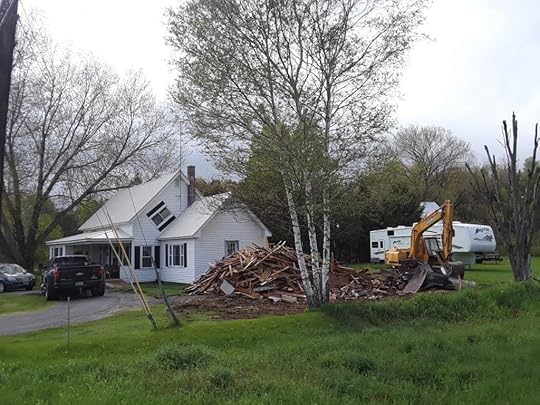Ripley Entertainment Inc.'s Blog, page 79
July 3, 2022
CARTOON 07-03-2022
July 2, 2022
CARTOON 07-02-2022
July 1, 2022
Amazon Alexa May Soon Sound Like Your Dead Relatives
Featured in Ripley's Believe It or Not!

The chance to be reunited with deceased loved ones is something money can’t buy even the richest man in the world, but Jeff Bezos (well, the company he founded) is going to try anyway.
Amazon’s latest endeavor is taking technology to the other side as the mega-corporation revealed its plans to reconnect grieving loved ones with their dearly departed through the power of artificial intelligence.
“Alexa, Play Grandma.”The new technology was unveiled last week during Amazon’s re:MARS AI conference, where tech enthusiasts gathered to see what the “brightest minds in science” have been up to lately.
When it came time to present, Amazon’s senior vice president and head scientist for Alexa, Rohit Prasad, introduced the company’s latest development — a way to change Alexa’s voice from drab to dead through vocal mimicking based on recordings less than a minute long.
He then tugged at the audience’s heartstrings further with a video featuring a small child asking Alexa if Grandma could finish reading him the The Wizard of Oz. The technology obliged, reading the rest of the book in a voice mimicking the presumably no-longer-with-us grandmother.
Memories To Last More than a Lifetime
Amazon just revealed a new Alexa feature that can learn to mimic the voices of dead relatives with less than a minute of recordings
pic.twitter.com/7UojMTEPdm
— Product Hunt
(@ProductHunt) June 23, 2022
While the developing tech could also work on living voices, the intention behind it is specifically to generate trust in the program by creating an emotional experience based on “human attributes of empathy and affect.”
“These attributes have become even more important during the ongoing pandemic when so many of us have lost ones that we love,” Prasad explained. “While AI can’t eliminate that pain of loss, it can definitely make their memories last.”
Calming or Controversial?Not everyone’s a fan of the idea of bringing their deceased relatives back to life, even if it is only in sound.
Amazon’s revelation has sparked a cold-blooded debate on whether the technology is creepy, calming, or even ethical, with many comparing it to dystopian sci-fi in which similar technology does much more harm than good.
Arizona State University professor Subbarao Kambhampati acknowledges that the technology may help some with the grieving process “in the same way we look back and watch videos of the departed,” but also raised concerns about the ethics of using a deceased person’s voice without consent, not to mention the potential for disaster in other uses.

Editorial credit: Whoever / Shutterstock.com
Trusted SourcesIt’s going to take a lot more than a familiar voice to get public approval of this controversial intelligence. Though there have always been myths and warnings about how far artificial intelligence can go, the possible downsides of this specific technology aren’t hard to imagine.
In a world of photo manipulation, video editing, and advanced sound production, it’s not exactly hard to falsify a record, video, image, or any other form of media.
Talks of deepfakes — media rendered using AI to dupe audiences into thinking someone did something that never occurred — are all the rage, and we’re living in an overwhelmingly distrusting time overall.
“As creepy as it might sound, it’s a good reminder that we can’t trust our own ears in this day and age,” said Kambhampati “But the sooner we get used to this concept, which is still strange to us right now, the better we will be.”
Despite these concerns, Prasad remains optimistic, saying, “we are unquestionably living in the golden era of AI, where our dreams and science fiction are becoming a reality.”
By Meghan Yani, contributor for Ripleys.com
EXPLORE THE ODD IN PERSON! Discover hundreds of strange and unusual artifacts and get hands-on with unbelievable interactives when you visit a Ripley’s Odditorium!Source: Amazon Alexa May Soon Sound Like Your Dead Relatives
CARTOON 07-01-2022
June 30, 2022
Did A Meteorite Lead To This City’s Extinction?
Featured in Ripley's Believe It or Not!

Thirty-seven miles outside of Flagstaff, Arizona, sits a reminder of the untold and nearly unpredictable forces at work above our heads. As you drive through the desert nearer and nearer to the landmark, the flat landscape begins to undulate, and as you reach the center of the ripples, you’ll find a 560-feet-deep hole in the planet that stretches 3,900 feet across!
Known as the Canyon Diablo meteorite, its crater is one of the best-preserved on Earth. Yet, despite its impressive size and the fact that fragments of the meteorite can be found in the desert sand for miles and miles, it hit in the middle of nowhere and was considered to be relatively small.
So what would happen if the meteorite was bigger and hit a populated center? Today, we’re going back 36,000 years to look at a real-life city hit by a meteorite.
Rock Your WorldIt was around 1650 B.C. when the city of Tall el-Hammam began a new day in the Jordan Valley. The biggest city in the region, its streets bustled with merchants and politicians working among the city’s 50,000-strong population.
The city was quite advanced for its time. Mud-brick buildings reached five stories into the sky, pottery was spun on wheels, grapes were cultivated, and bronze and silver were cast.
But the city disappeared one day, literally wiped off the map. The site would eventually be resettled a few times throughout the ensuing millennia, but archeologists have been baffled by the original city’s fate for decades. Strange discoveries uncovered in the ancient rubble have been hard to explain.
Melted remains and layers of ash were discovered, suggesting a fire may have destroyed the city, but clay pots melted on the outside were smooth and untouched inside — not the signs of a raging fire.
Meteorite MayhemScientists instead now believe the city was the victim of a meteorite. Unlike the Canyon Diablo, this meteorite exploded as it reached the atmosphere above the city and released a blast 1,000 times more powerful than an atomic bomb!
According to archaeologist Christopher R. Moore, the extra-terrestrial rock exploded 2.5 miles above the city. The energy heated the air to more than 3,600°F. All clothing and wood in the area instantly burst into flames, burning people alive and collapsing buildings. Swords, spears, pottery, and even the buildings’ bricks began to melt.

Finally, a few seconds later, the shockwave hit.
Winds exceeding any recorded tornado whipped through the city at 740 mph, destroying all that was left. No bodies or bones of animals have ever been found at the site because they were all blasted into small fragments.
No one survived, and the blast actually reached far enough toward the Dead Sea to disperse salt all across the region, making it un-farmable for centuries. Many believe this city inspired the biblical story of Sodom being pelted with fire and brimstone in the book of Genesis.
Eyes to the SkyThe question you’re probably asking now is, could it happen again? Airbursts like the one that hit Tall el-Hammam aren’t actually that rare in the modern century, though they are a relatively recently recognized phenomenon.
The first verified observed air burst took place in 1908 and was the largest witnessed… so far. Known as the Tunguska Event, this meteorite exploded over northern Russia, sending shockwaves as far as the United Kingdom! Eighty million trees fell in an instant, windows broke 40 miles away, and a glow on the horizon was visible from the United States!

Fallen trees at Tunguska.
A mysterious event at first, nations worried some sort of existential doom may be facing the planet, and, in a way, they weren’t wrong. But for decades, the event was simply unexplained. It took researchers recovering extra-terrestrial samples from the blast site to really put the idea of air impact meteorites together. As they began to piece information together, they provided a solution to a whole host of archaeological mysteries.
One of which being an alien brooch worn by King Tutankhamun, who — when archaeologists discovered him — was wearing a glass scarab predating the pharaoh by 28 million years!
The answer to this Egyptian mystery actually came from outer space. The scarab was molded from glass formed when a meteorite exploded over the Sahara, turning pieces of the desert into glass that can still be found to this day. In fact, we even have a few pieces in the Ripley’s collection!
EXPLORE THE ODD IN PERSON! Discover hundreds of strange and unusual artifacts and get hands-on with unbelievable interactives when you visit a Ripley’s Odditorium!Why Do Vermont Homes Have Crooked Windows?
Featured in Ripley's Believe It or Not!

From verdant forested lands to rolling emerald hills, Vermont is chock-full of pastoral landscapes, scenic wilderness hikes, and picturesque covered bridges, per Time Out. The second-least populated state in the US, the “Green Mountain State” was first discovered by Samuel de Champlain of France in 1609 (via America’s Library). A century and a half later, figures like Ethan Allen and the Green Mountain Boys defended it from Great Britain’s tyranny and taxes.
Agriculture still bolsters the economy, producing sugar maple, cheese, beer, vegetables, and more. But there’s something else the state’s famous for that you may not know about, especially if you’ve never driven through Vermont country. Call them witch windows, coffin windows, or Vermont windows. No matter which term you favor, they all feature the same distinctive look — a window turned sideways and placed at a 45-degree angle in a farmhouse’s gable-end wall.
Unique to the Eastern Seaboard, these cattywampus apertures predominate in Vermont, where numerous legends have arisen to explain them. Here’s the scoop on these marvels of vernacular architecture and their colorful origins.
Witch WindowsVermont’s famed sideways windows are found most commonly in 19th-century farmhouses, although some can still be seen today in more recent construction. Although these windows can be found in other New England states, Vermont boasts more than any other region. What’s more, other states haven’t spent much time explaining the origins of these so-called lazy windows. But in Vermont, colorful fables abound about them, including one involving witches.
Positioned at 45°, witch windows are almost exclusively found in the US state of Vermont. The term witch window comes from the belief that witches cannot fly their broomsticks through tilted windows. (Image: Piledhigheranddeeper) pic.twitter.com/dPZwt3E9qU
— Quite Interesting (@qikipedia) March 22, 2019
According to legend, sideways windows may have gotten the nickname “witch windows” because of an old wives’ tale about these supernatural entities. As the legend goes, witches couldn’t fly their trusty broomsticks through off-balance windows. Hence, the strange alignment. But was witchcraft really a thing in historical Vermont? According to Obscure Vermont, “There isn’t much known on how scared Vermonters were of witches, leaving this as intriguing speculation.” But the explanations don’t stop with broomstick-wielding magic makers.
Coffin WindowsOther Vermonters refer to them as “coffin windows,” and they’ve got an equally implausible reason for this moniker. They claim the windows came in handy when removing people who died from the upper stories of a home. They felt it was easier to throw the full coffin outside where it could slide down the roof’s slant to the ground. Why couldn’t they simply take the stairs? Because of the super steep and narrow staircases featured in many Vermont farmhouses.
But there are also problems with this theory. For starters, it’s hard to fathom so many people dying upstairs it required permanent architectural alterations. This legend also begs the question: why not carry the bodies downstairs before placing them in coffins? In other words, the coffin window theory also leaves many unanswered questions. But perhaps a little common sense provides the real answer.
Vermont WindowsPerhaps the best answer to how and why Vermont windows came into existence is also the simplest: It could have just been a matter of practicality and affordability. The windows may have been shoved into place to provide air and light to upstairs rooms. During the summer months, these rooms would have been rendered nearly unusable by rising heat. But the windows helped, providing the most bang for a farmer’s buck.

Credit: Artaxerxes Via Wikimedia Commons (CC BY-SA 4.0)
What’s more, this fix didn’t require having custom windows built, which would have proven cost-prohibitive for most families. Yet, it still delivered big on light and passive ventilation, both vital to those living on the upper levels of a house. As Obscure Vermont points out, “Though there are far more scolding environments than Vermont, our summers do get pretty humid, and the upper floors of an old house easily turn into ovens.”
Whatever the case, Vermont windows have captured the local imagination, inspiring Instagram accounts and even coffee table books like Jim Stoops’ On a Vermont Witch’s Window Trail a Pictorial Trail Guide. There’s even a brewery in South Burlington, Vermont, known as the Weird Window Brewing company. The brewery’s logo depicts one of the crooked windows, and a few swigs of their product might have people seeing more than crooked windows.
By Engrid Barnett, contributor for Ripleys.com
EXPLORE THE ODD IN PERSON! Discover hundreds of strange and unusual artifacts and get hands-on with unbelievable interactives when you visit a Ripley’s Odditorium!CARTOON 06-30-2022
June 29, 2022
Up Close & Peculiar With Vintage Spy Gear!
Featured in Ripley's Believe It or Not!

Today: Vintage Spy Gear
Here at Ripley’s, we’re no strangers to unusual and intriguing artifacts. Today, we are diving into one of our most curious collections to take a closer look at our vintage and historical spy gear. From hidden cameras to bugs of all shapes and sizes, no one was safe when these artifacts were being used by a skilled agent! Many of the incredible gadgets date back to the Cold War Era or were used by the KGB. To see just how technologically advanced they were for their time is truly something unbelievable!
Get up close with some creative gadgets that were highly effective in gathering intelligence from unsuspecting individuals. Ask yourself — would you really know if someone was spying on you? Tell us what you think and let us know which gadget was your favorite after learning about these iconic spy artifacts, straight from the Ripley’s Vault!
EXPLORE THE ODD IN PERSON! Discover hundreds of strange and unusual artifacts like this one, and get hands-on with unbelievable interactives when you visit a Ripley’s Odditorium!The Surprisingly Long History Of Real Flying Cars
Featured in Ripley's Believe It or Not!

For decades, people have dreamed about the possibility of hitting the skies in their own personal flying car. Think about it — wouldn’t it be nice to trade in the headache of rush-hour traffic for a relaxing ride through the sky?
Fortunately, thanks to some forward-thinking startups, the future of flying cars is closer than you think. Financial services company Morgan Stanley even predicts that the air mobility market could be worth a whopping $1 trillion by 2040!
Companies such as Joby Aviation and Archer Aviation are already developing electric vertical take-off and landing vehicles (eVTOLs). And everyone from Uber to the U.S. Air Force is jumping on the bandwagon, with the latter planning to use flying cars to carry passengers and cargo.
Embed from Getty Imageswindow.gie=window.gie||function(c){(gie.q=gie.q||[]).push(c)};gie(function(){gie.widgets.load({id:'zqun37kISO1i6abTZacCiQ',sig:'aMMhWme0n1mL6APvNVfmQ062O8xxx66DmNRSE0e9Kxk=',w:'594px',h:'396px',items:'1234620628',caption: true ,tld:'com',is360: false })});
But while the idea of flying cars seems like it was dreamed up by a team of Hollywood script writers or Silicon Valley startups, the concept has actually been around for more than 100 years.
A Century of Flying Car ConceptsThe first concept of an aviation vehicle that a person could drive was patented way back in 1910. Henry Ford even had big hopes for an experimental single-seat aircraft that he dubbed the “Ford Flivver,” though his plans never came to fruition.
Developers didn’t see success until 1937, when the Waterman Arrowbile sailed through the skies. Sadly, the nifty little tailless two-seater wasn’t wildly popular and only five were ever produced.
Nine years later in 1946, the Fulton FA-2 Airphibian, a roadable aircraft, was created. Though not very practical, the vehicle did come with removable tail sections and wings.

The Fulton FA-2 Airphibian. Credit: Alan Wilson via Wikimedia Commons (CC BY-SA 2.0)
Several others tried their hands at flying car concepts, including the ConvAirCar of the 1940s, which was basically just a sedan strapped to the bottom of an airplane (pictured at the top of this article).
In 1959, the Canadian and British military developed the Avrocar, the first flying car specifically intended for military use. The machine looked more like a flying saucer than a car.
US National Archives via GIPHY
Far from the UFO design of the Avrocar was the adorable Aerocar, a concept created by aeronautical engineer Moulton Taylor. It was designed to drive, fly, then drive again without any disruptions. Ford even considered marketing the vehicle.
Embed from Getty Imageswindow.gie=window.gie||function(c){(gie.q=gie.q||[]).push(c)};gie(function(){gie.widgets.load({id:'nsE4oYYTR2ZFYoUEUK7t0A',sig:'lJw72B-eenQFz5JuxMFIj3SagmtQGrikrkIq2bYOPMQ=',w:'594px',h:'418px',items:'1368475805',caption: true ,tld:'com',is360: false })});
One of the most valiant efforts to bring flying cars to the market was Paul Moller. He spent millions of dollars and nearly 40 years developing his Skycar. He listed his vehicle on eBay in 2017 with a Buy-It-Now price of $5 million.
The Future of Flying Cars Looks BrightWhile nobody wants to fly a minivan bolted to a plane, today’s flying cars look much more promising than their precursors.
The Aeromobil 4.0, Klein Vision AirCar, and Renault AIR4 are all strong contenders for the sky highways of the near future.
By Stephanie Weaver, contributor for Ripleys.com
EXPLORE THE ODD IN PERSON! Discover hundreds of strange and unusual artifacts and get hands-on with unbelievable interactives when you visit a Ripley’s Odditorium!CARTOON 06-29-2022
Ripley Entertainment Inc.'s Blog
- Ripley Entertainment Inc.'s profile
- 52 followers








